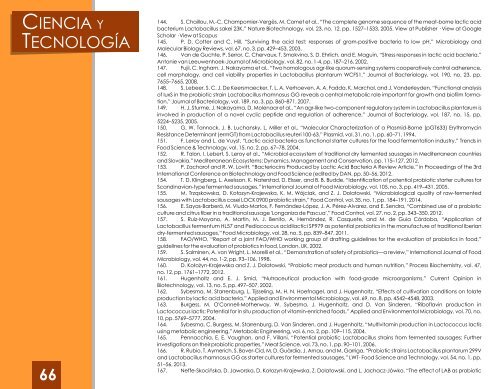Carnepress Diciembre 2017
Create successful ePaper yourself
Turn your PDF publications into a flip-book with our unique Google optimized e-Paper software.
CIENCIA Y<br />
TECNOLOGÍA<br />
66<br />
144. S. Chaillou, M.-C. Champomier-Vergès, M. Cornet et al., “The complete genome sequence of the meat-borne lactic acid<br />
bacterium Lactobacillus sakei 23K,” Nature Biotechnology, vol. 23, no. 12, pp. 1527–1533, 2005. View at Publisher · View at Google<br />
Scholar · View at Scopus<br />
145. P. D. Cotter and C. Hill, “Surviving the acid test: responses of gram-positive bacteria to low pH,” Microbiology and<br />
Molecular Biology Reviews, vol. 67, no. 3, pp. 429–453, 2003.<br />
146. Van de Guchte, P. Serror, C. Chervaux, T. Smokvina, S. D. Ehrlich, and E. Maguin, “Stress responses in lactic acid bacteria,”<br />
Antonie van Leeuwenhoek-Journal of Microbiology, vol. 82, no. 1-4, pp. 187–216, 2002.<br />
147. Fujii, C. Ingham, J. Nakayama et al., “Two homologous agr-like quorum-sensing systems cooperatively control adherence,<br />
cell morphology, and cell viability properties in Lactobacillus plantarum WCFS1,” Journal of Bacteriology, vol. 190, no. 23, pp.<br />
7655–7665, 2008.<br />
148. S. Lebeer, S. C. J. De Keersmaecker, T. L. A. Verhoeven, A. A. Fadda, K. Marchal, and J. Vanderleyden, “Functional analysis<br />
of luxS in the probiotic strain Lactobacillus rhamnosus GG reveals a central metabolic role important for growth and biofilm formation,”<br />
Journal of Bacteriology, vol. 189, no. 3, pp. 860–871, 2007.<br />
149. H. J. Sturme, J. Nakayama, D. Molenaar et al., “An agr-like two-component regulatory system in Lactobacillus plantarum is<br />
involved in production of a novel cyclic peptide and regulation of adherence,” Journal of Bacteriology, vol. 187, no. 15, pp.<br />
5224–5235, 2005.<br />
150. G. W. Tannock, J. B. Luchansky, L. Miller et al., “Molecular Characterization of a Plasmid-Borne (pGT633) Erythromycin<br />
Resistance Determinant (ermGT) from Lactobacillus reuteri 100-63,” Plasmid, vol. 31, no. 1, pp. 60–71, 1994.<br />
151. F. Leroy and L. de Vuyst, “Lactic acid bacteria as functional starter cultures for the food fermentation industry,” Trends in<br />
Food Science & Technology, vol. 15, no. 2, pp. 67–78, 2004.<br />
152. R. Talon, I. Lebert, S. Leroy et al., “Microbial ecosystem of traditional dry fermented sausages in Mediterranean countries<br />
and Slovakia,” Mediterranean Ecosystems: Dynamics, Management and Conservation, pp. 115–127, 2012.<br />
153. P. Zacharof and R. W. Lovitt, “Bacteriocins Produced by Lactic Acid Bacteria A Review Article,” in Proceedings of the 3rd<br />
International Conference on Biotechnology and Food Science (edited by DAN, pp. 50–56, 2012.<br />
154. T. D. Klingberg, L. Axelsson, K. Naterstad, D. Elsser, and B. B. Budde, “Identification of potential probiotic starter cultures for<br />
Scandinavian-type fermented sausages,” International Journal of Food Microbiology, vol. 105, no. 3, pp. 419–431, 2005.<br />
155. M. Trząskowska, D. Kołozyn-Krajewska, K. M. Wójciak, and Z. J. Dolatowski, “Microbiological quality of raw-fermented<br />
sausages with Lactobacillus casei LOCK 0900 probiotic strain,” Food Control, vol. 35, no. 1, pp. 184–191, 2014.<br />
156. E. Sayas-Barberá, M. Viuda-Martos, F. Fernández-López, J. A. Pérez-Alvarez, and E. Sendra, “Combined use of a probiotic<br />
culture and citrus fiber in a traditional sausage 'Longaniza de Pascua',” Food Control, vol. 27, no. 2, pp. 343–350, 2012.<br />
157. S. Ruiz-Moyano, A. Martín, M. J. Benito, A. Hernández, R. Casquete, and M. de Guia Córdoba, “Application of<br />
Lactobacillus fermentum HL57 and Pediococcus acidilactici SP979 as potential probiotics in the manufacture of traditional Iberian<br />
dry-fermented sausages,” Food Microbiology, vol. 28, no. 5, pp. 839–847, 2011.<br />
158. FAO/WHO, “Report of a joint FAO/WHO working group of drafting guidelines for the evaluation of probiotics in food,”<br />
guidelines for the evaluation of probiotics in food, London, UK, 2002.<br />
159. S. Salminen, A. von Wright, L. Morelli et al., “Demonstration of safety of probiotics—a review,” International Journal of Food<br />
Microbiology, vol. 44, no. 1-2, pp. 93–106, 1998.<br />
160. D. Kołożyn-Krajewska and Z. J. Dolatowski, “Probiotic meat products and human nutrition,” Process Biochemistry, vol. 47,<br />
no. 12, pp. 1761–1772, 2012.<br />
161. Hugenholtz and E. J. Smid, “Nutraceutical production with food-grade microorganisms,” Current Opinion in<br />
Biotechnology, vol. 13, no. 5, pp. 497–507, 2002.<br />
162. Sybesma, M. Starrenburg, L. Tijsseling, M. H. N. Hoefnagel, and J. Hugenholtz, “Effects of cultivation conditions on folate<br />
production by lactic acid bacteria,” Applied and Environmental Microbiology, vol. 69, no. 8, pp. 4542–4548, 2003.<br />
163. Burgess, M. O'Connell-Motherway, W. Sybesma, J. Hugenholtz, and D. Van Sinderen, “Riboflavin production in<br />
Lactococcus lactis: Potential for in situ production of vitamin-enriched foods,” Applied and Environmental Microbiology, vol. 70, no.<br />
10, pp. 5769–5777, 2004.<br />
164. Sybesma, C. Burgess, M. Starrenburg, D. Van Sinderen, and J. Hugenholtz, “Multivitamin production in Lactococcus lactis<br />
using metabolic engineering,” Metabolic Engineering, vol. 6, no. 2, pp. 109–115, 2004.<br />
165. Pennacchia, E. E. Vaughan, and F. Villani, “Potential probiotic Lactobacillus strains from fermented sausages: Further<br />
investigations on their probiotic properties,” Meat Science, vol. 73, no. 1, pp. 90–101, 2006.<br />
166. R. Rubio, T. Aymerich, S. Bover-Cid, M. D. Guàrdia, J. Arnau, and M. Garriga, “Probiotic strains Lactobacillus plantarum 299V<br />
and Lactobacillus rhamnosus GG as starter cultures for fermented sausages,” LWT- Food Science and Technology, vol. 54, no. 1, pp.<br />
51–56, 2013.<br />
167. Neffe-Skocińska, D. Jaworska, D. Kołozyn-Krajewska, Z. Dolatowski, and L. Jachacz-Jówko, “The effect of LAB as probiotic

















